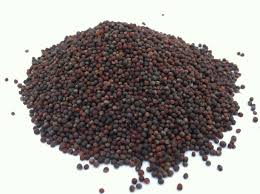
Let’s talk about the canola plant.
The history of how the canola plant came to be is important: a key misunderstanding that people have about canola oil is that it can’t be organic or non-gmo because it was genetically modified from a rapeseed plant to become a canola plant. They believe that being genetically modified is a basic pre-requisite for existing.
This is not true, and is a misunderstanding of the timeline of events and what occurred.
The history of the canola plant will help illustrate the story of what really happened and why non-gmo and organic canola seeds, grown without genetic modification, really do exist.
Canola: A Younger Cousin of Rapeseed
The canola plant is a “distant younger cousin” of the rapeseed plant. The rapeseed plant was originally grown to make meal for cows in the latter half of the 20th century. Rapeseed plants naturally had mid-to-high levels of eurcic acid, which is a component of each fat molecule. A ruminant cow can easily ingest this eurcic acid in its 4 stomachs, but the human digestion can’t take much of it.
Don’t think of eurcic acid as a bad thing just because of the word “acid” — all oils come with many different kinds of fatty acids. Oleic acid, for example, is another term for healthy monounsaturated fats that are found in olive oil and avocados.
Where The Name Canola Comes From
 In the 70s, scientists and farmers worked to produce a similar plant that had much lower levels of eurcic acid for people to use and eat. This new low-eurcic acid plant, they renamed canola oil (because, let’s be real, who would have chosen the name “rapeseed” to begin with? To me, it’s an unfortunate choice).
In the 70s, scientists and farmers worked to produce a similar plant that had much lower levels of eurcic acid for people to use and eat. This new low-eurcic acid plant, they renamed canola oil (because, let’s be real, who would have chosen the name “rapeseed” to begin with? To me, it’s an unfortunate choice).
The new name came from the acronym CANadian Oil Low Acid… CAN-O-L-A.
Traditional Breeding Of Canola Plants
This new canola plant was developed using traditional breeding methods (think Gregor Mendel’s pea plant experiment). Another way to look at it is by looking at other traditional breeding methods, like the way animals and humans pass traits through generations. In this example, if you breed a brown chicken with a white one, you can create a speckled white and brown chick. Then you breed that speckled brown & white chicken, once grown, to a white chicken to a create an even-more-white-speckled chicken. Aka, it’s selective breeding but done naturally. However, it’s important to not that genetic modification wasn’t extensively used yet at this point back in the 70s!
The Rise of Genetic Modification
For the next few decades, the use of canola oil and meal grew throughout the US and Canada. Then, in the 90s, genetic modification became a very popular new thing. Farmers wanted higher yields and they took these seeds (already canola seeds at this point) and genetically modified them to make them resistant to RoundUp. Soon almost all of the canola in the US was genetically modified; in recent years, over 96% of canola crops were GM — this number is now slowly dropping as non-gmo canola becomes more and more in demand.
The Original Seeds Used To Make Non-GMO & Organic Canola

However, there were still those original seeds floating around, produced through traditional breeding back in the 70s that were never touched by genetic modification.
These seeds became the mainstay used for non-gmo and organic canola oil production today.
This is a key difference between organic vs. non-organic canola. Organic canola oil (and non-gmo canola oil) uses the original seeds from the 70s, while the non-organic canola uses the newer genetically modified versions.
Other differences include the fact that conventional canola oil is often solvent expelled using a chemical like hexane, while organic and non-gmo canola oils are expeller pressed.
More Resources
Want to learn more about organic canola oil or non-GMO canola oil and how it compares to conventional GM canola oil? We suggest reading the following articles:
Why Non-Gmo Canola Oil Does, In Fact, Exist
Organic Canola Oil — Isn’t That An Oxymoron? Nope, It Exists
Debunking 5 Myths About Organic Canola Oil
Canola Oil Myths And Truths
Topics: Canola Oil, Non-GMO












